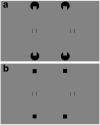Visuospatial interpolation in typically developing children and in people with Williams Syndrome
- PMID: 18782587
- PMCID: PMC2577723
- DOI: 10.1016/j.visres.2008.08.012
Visuospatial interpolation in typically developing children and in people with Williams Syndrome
Abstract
Visuospatial interpolation is the estimation of object position or contour shape computed from known "anchor" positions. We characterized the developmental profile of interpolation by measuring positional thresholds as a function of inter-element separation without (Experiment 1) and with (Experiment 2) the context of illusory contours in typically developing children, typical adults and individuals with Williams Syndrome (WS), a genetic disorder that causes impaired global visuospatial abilities. We found that typically developing children and WS individuals had more difficulty integrating information across distant elements than typical adults. However, illusory contours improved thresholds in all participant groups in a similar way. Our results suggest that in WS individuals, and in typically developing children, the grouping mechanisms that enable long-range spatial integration are immature. We hypothesize that WS individuals and young children can use stimulus-driven grouping cues for bottom-up integration, but have immature mechanisms for top-down integration of spatial information.
Figures















Similar articles
-
Orientation perception in Williams Syndrome: discrimination and integration.Brain Cogn. 2009 Jun;70(1):21-30. doi: 10.1016/j.bandc.2008.11.007. Epub 2009 Feb 23. Brain Cogn. 2009. PMID: 19231058 Free PMC article.
-
Normal susceptibility to visual illusions in abnormal development: evidence from Williams syndrome.Perception. 2009;38(2):186-99. doi: 10.1068/p6044. Perception. 2009. PMID: 19400429 Free PMC article.
-
Developmental profiles for multiple object tracking and spatial memory: typically developing preschoolers and people with Williams syndrome.Dev Sci. 2010 May;13(3):430-440. doi: 10.1111/j.1467-7687.2009.00893.x. Dev Sci. 2010. PMID: 20443964 Free PMC article.
-
From genes to brain development to phenotypic behavior: "dorsal-stream vulnerability" in relation to spatial cognition, attention, and planning of actions in Williams syndrome (WS) and other developmental disorders.Prog Brain Res. 2011;189:261-83. doi: 10.1016/B978-0-444-53884-0.00029-4. Prog Brain Res. 2011. PMID: 21489394 Review.
-
Visuospatial cognition in Williams syndrome: reviewing and accounting for the strengths and weaknesses in performance.Dev Neuropsychol. 2003;23(1-2):173-200. doi: 10.1080/87565641.2003.9651891. Dev Neuropsychol. 2003. PMID: 12730024 Review.
Cited by
-
Orientation perception in Williams Syndrome: discrimination and integration.Brain Cogn. 2009 Jun;70(1):21-30. doi: 10.1016/j.bandc.2008.11.007. Epub 2009 Feb 23. Brain Cogn. 2009. PMID: 19231058 Free PMC article.
-
Space and language in Williams syndrome: insights from typical development.Wiley Interdiscip Rev Cogn Sci. 2013 Nov;4(6):693-706. doi: 10.1002/wcs.1258. Epub 2013 Sep 30. Wiley Interdiscip Rev Cogn Sci. 2013. PMID: 24839539 Free PMC article. Review.
-
Parts function as perceptual organizational entities in infancy.Psychon Bull Rev. 2013 Aug;20(4):726-31. doi: 10.3758/s13423-013-0385-4. Psychon Bull Rev. 2013. PMID: 23359419
References
-
- Altmann CF, Bulthoff HH, Kourtzi Z. Perceptual organization of local elements into global shapes in the human visual cortex. Curr Biol. 2003;13(4):342–349. - PubMed
-
- Atkinson J, Braddick O. Assessment of visual acuity in infancy and early childhood. Acta Ophthalmol Suppl. 1983;157:18–26. - PubMed
-
- Atkinson J, Braddick O, Anker S, Curran W, Andrew R, Wattam-Bell J, Braddick F. Neurobiological models of visuospatial cognition in children with Williams syndrome: measures of dorsal-stream and frontal function. Dev Neuropsychol. 2003;23(1–2):139–172. - PubMed
-
- Bellugi U, Lichtenberger L, Mills D, Galaburda A, Korenberg JR. Bridging cognition, the brain and molecular genetics: evidence from Williams syndrome. Trends Neurosci. 1999;22(5):197–207. - PubMed
-
- Bihrle AM, Bellugi U, Delis D, Marks S. Seeing either the forest or the trees: dissociation in visuospatial processing. Brain Cogn. 1989;11(1):37–49. - PubMed
MeSH terms
Grants and funding
LinkOut - more resources
Full Text Sources

